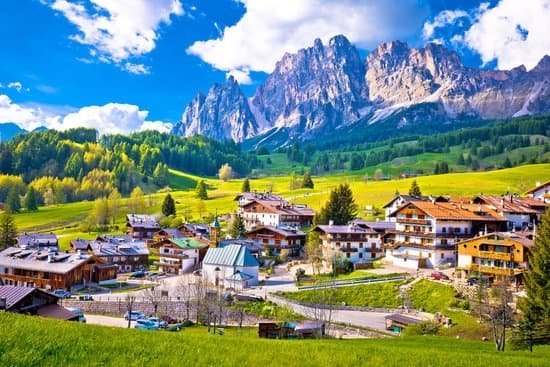Italy is a beautiful and diverse country, with each city offering its own unique charm and attractions. From the ancient ruins of Rome to the romantic canals of Venice, there’s no shortage of amazing destinations to explore.
But with so many incredible cities to choose from, planning your itinerary can be overwhelming. In this article, we will provide you with tips on how to travel to different cities in Italy, including how to plan your itinerary and map out your travel route.
One of the first things to consider when planning a trip to Italy is which cities you want to visit. With so many iconic destinations, it can be difficult to narrow down your options. We’ll provide you with helpful tips for choosing which cities best suit your interests and travel style. Whether you’re interested in history, art, food, or landscapes, we’ll help you determine which cities are must-sees for your trip.
Once you’ve chosen the cities you want to visit, the next step is figuring out how to map out your travel route in Italy. This involves considering factors such as proximity, transportation options between cities, and the amount of time you have for your trip.
We’ll offer advice on how to design a practical and efficient itinerary that allows you to make the most of your time in each city without feeling rushed. With our tips, you’ll be able to create an itinerary that maximizes your experience in each destination while allowing for smooth travel transitions between cities.
Transportation Options
When traveling between cities in Italy, there are several transportation options to consider. Each mode of transportation offers its own unique experience and benefits, so it’s important to weigh the pros and cons of each.
Trains
Italy is known for its extensive and efficient train system, making it one of the most popular ways to travel between cities. The high-speed trains, such as the Frecciarossa, offer quick travel times between major cities and a comfortable ride. It’s recommended to book train tickets in advance to secure the best fares and seat options.
Buses
For those looking for a more budget-friendly option, buses are a great way to travel between cities in Italy. Companies like FlixBus and MarinoBus offer affordable and convenient routes to various destinations across the country. While travel times may be longer than trains, buses provide an opportunity to see the countryside and smaller towns along the way.
Rental Cars
Renting a car can give travelers the flexibility to explore lesser-known areas in Italy at their own pace. However, driving in Italian cities can be challenging due to congestion and limited parking. Additionally, some city centers have restricted zones where only residents are permitted to drive. It’s important to research local traffic rules and parking options before renting a car in Italy.
Ultimately, the best transportation option for traveling between cities in Italy depends on individual preferences, budget, and itinerary. Whether travelers opt for trains, buses, or rental cars, each mode of transportation has its own advantages for exploring all that Italy has to offer.
Navigating Italian Public Transportation
Italy has a well-developed public transportation system that makes it easy to navigate between cities. The country’s extensive network of trains, buses, and trams provides convenient and affordable options for traveling within Italy. When using Italy’s public transportation system, it is important to familiarize yourself with the ticketing process, schedules, and local tips to make the most of your travel experience.
One of the most popular modes of public transportation in Italy is the train. The Italian rail network is known for its efficiency and accessibility, making it a convenient option for traveling between major cities. With various train classes available, including high-speed trains such as Trenitalia’s Frecciarossa and Italo, passengers can reach their destinations quickly and comfortably. It is recommended to book tickets in advance, especially during peak travel seasons, to secure the best fares and schedules.
In addition to trains, Italy also offers an extensive bus network that connects cities and towns throughout the country. Bus travel is a cost-effective option for getting around Italy, particularly for reaching destinations that are not serviced by trains.
Companies such as FlixBus and MarinoBus operate routes between major Italian cities, providing travelers with an alternative mode of transportation. Understanding the different bus companies and their schedules can help you plan your itinerary effectively and explore more destinations during your visit to Italy.
| Italian Public Transportation Tips | Information |
|---|---|
| Train Options | High-speed trains like Frecciarossa and Italo offer quick travel between cities. |
| Bus Travel | FlixBus and MarinoBus provide affordable options for reaching destinations not serviced by trains. |
Must-See Cities
Italy is a country known for its rich history, stunning architecture, and delicious cuisine. When planning a trip to Italy, it’s essential to include some of the must-see cities in your itinerary. Rome, Venice, Florence, and Milan are just a few of the cities that offer unique experiences and attractions.
Rome, the capital city of Italy, is a treasure trove of ancient history and culture. Visitors can explore iconic landmarks such as the Colosseum, Roman Forum, and Pantheon. The Vatican City, an independent city-state within Rome, is home to St. Peter’s Basilica and the Sistine Chapel, making it a must-visit for art and religious enthusiasts.
Venice is known for its picturesque canals, colorful buildings, and romantic ambiance. Visitors can take a gondola ride along the Grand Canal or explore famous landmarks like St. Mark’s Square and Doge’s Palace. Venice is also famous for its annual Carnival celebration, which showcases elaborate masks and costumes.
Florence is celebrated for its Renaissance art and architecture. The city is home to world-renowned museums such as the Uffizi Gallery and the Accademia Gallery, where visitors can see masterpieces by artists like Michelangelo and Botticelli. The iconic Duomo Cathedral and Ponte Vecchio bridge are also must-see attractions in Florence.
Milan is Italy’s fashion capital and a thriving metropolis known for its shopping districts and vibrant nightlife. Visitors can admire architectural marvels such as the Milan Cathedral (Duomo di Milano) or visit cultural institutions like the Teatro alla Scala opera house. Milan also offers excellent opportunities for dining at trendy restaurants or enjoying an espresso at a stylish café.
These cities offer diverse experiences that showcase different aspects of Italian culture and history. Including these must-see cities in your travel itinerary ensures an unforgettable journey through Italy’s most iconic destinations.
Accommodation Tips
When traveling to different cities in Italy, it’s essential to find the right accommodations for your stay. Whether you prefer the luxury of a hotel, the budget-friendly option of a hostel, or the unique experience of an Airbnb, there are plenty of options to choose from in each city you visit.
Hotels
Italy is known for its beautiful hotels, offering a range of amenities and services for travelers. When looking for hotel accommodations in cities like Rome, Venice, Florence, and Milan, consider factors such as location, price, and included amenities. Many hotels in Italy offer breakfast as part of the stay and have concierge services that can help with recommendations for dining and sightseeing.
Hostels
For budget-friendly travelers or those looking to meet other like-minded individuals, hostels are a great option. Throughout Italy’s cities, there are plenty of hostels that offer dormitory-style rooms as well as private rooms at affordable rates. Hostels also often have common areas where guests can socialize and gather information about local activities and attractions.
Airbnb
For a more unique and local experience, consider booking an Airbnb during your travels through Italy. Many cities offer a wide range of options including private rooms within someone’s home or entire apartments or houses available for rent. Staying in an Airbnb can provide a more authentic cultural experience and often comes with added benefits such as access to a kitchen for cooking meals and insider tips from locals on where to visit nearby.
Budget-Friendly Travel
Traveling to different cities in Italy on a budget is definitely achievable with the right planning and money-saving tips. Here are some strategies for keeping costs down while exploring this beautiful country:
- Use public transportation: Italy has an extensive and reliable public transportation system, including buses, trams, and metro systems in major cities. Opting for these modes of transport over taxis can save you a significant amount of money during your travels.
- Look for budget accommodations: While Italy is known for its luxury hotels, there are also plenty of affordable options available. Consider staying in hostels or searching for budget-friendly hotels to cut down on your accommodation costs.
- Take advantage of free attractions: Many of Italy’s most famous landmarks and attractions are free to visit, such as St. Peter’s Basilica in Rome and the Trevi Fountain. By prioritizing these no-cost activities, you can enjoy a fulfilling travel experience without breaking the bank.
By following these budget-friendly tips, travelers can explore the diverse cities of Italy without overspending.
Ultimately, traveling to different cities in Italy on a budget is all about making smart choices and seeking out cost-effective options during your trip. With careful planning and research, it’s possible to enjoy all that this stunning country has to offer without emptying your wallet. Whether it’s choosing affordable accommodations, using public transportation wisely, or seeking out free attractions, there are ample opportunities to save money while experiencing the rich culture and history of Italy.
Cultural Etiquette and Tips
When traveling to a different city in Italy, it’s important to understand and respect the cultural norms and customs of the country. Here are some tips for navigating the local customs in Italy:
- Dining: In Italy, dining is an integral part of the culture, and there are certain customs that visitors should be aware of. For example, it’s considered rude to ask for substitutions or changes to a dish on the menu. Additionally, tipping is not as common in Italy as it is in other countries. A “service charge” may already be included in the bill, so be sure to check before leaving additional gratuity.
- Communicating: Italian is the official language of Italy, so it can be helpful to learn a few basic phrases before visiting. While many Italians speak English, especially in tourist areas, making an effort to communicate in Italian is appreciated. It’s also important to remember that Italians tend to speak more loudly and gesticulate more while conversing than people from other cultures.
- Local Customs: When visiting churches or religious sites, be mindful of your attire. It’s customary to dress modestly and cover shoulders and knees when entering these places. Additionally, shaking hands with everyone present upon arriving at a social gathering is considered polite in Italian culture.
Overall, being respectful and observant of local customs goes a long way when traveling through different cities in Italy. By following these tips for dining, communicating, and navigating local customs, visitors can have a more enjoyable and authentic experience during their travels.
Packing Recommendations
In conclusion, packing for a trip to Italy can be both exciting and challenging. With the diverse range of cities and experiences that the country offers, it’s important to pack smartly in order to make the most of your travels.
When preparing for your trip, consider the season and climate of the cities you plan to visit. For example, if you’re traveling during the summer months, lightweight and breathable clothing will be essential, while a winter trip will require warm layers and outerwear.
Additionally, keep in mind that many Italian cities have cobblestone streets and uneven terrain, so comfortable walking shoes are a must. Packing versatile pieces that can be mixed and matched is key for creating different outfits without over-packing. It’s also worth noting that Italy is known for its fashion-forward culture, so consider bringing some stylish attire if you plan to dine at upscale restaurants or attend cultural events during your visit.
Lastly, it’s important to remember that when traveling between different cities in Italy, you may encounter varying dress codes. While Italian cities are generally quite fashionable, more conservative attire may be expected when visiting religious sites or attending formal events.
Being mindful of these cultural norms will not only help you blend in with the locals but also show respect for the traditions and customs of each city you visit. By packing thoughtfully and considering these recommendations, you’ll be well-prepared for an unforgettable adventure through the beautiful cities of Italy.
Frequently Asked Questions
What is the best way to get to different cities in Italy?
The best way to get to different cities in Italy is by using the extensive and efficient train network. Italy has a well-connected railway system, making it easy to travel between major cities like Rome, Florence, Venice, Milan, and Naples. High-speed trains are a popular option for long distances as they offer convenience and comfort for travelers.
What is the best way to explore Italy?
The best way to explore Italy is by immersing yourself in the local culture and lifestyle. This means embracing the slower pace of life, enjoying leisurely meals at local trattorias, wandering through historic neighborhoods, and taking the time to appreciate famous landmarks and hidden gems.
Whether you’re exploring bustling cities or charming coastal towns, taking in the sights, sounds, and flavors of Italy is an experience that shouldn’t be rushed.
What is the cheapest way to travel within Italy?
The cheapest way to travel within Italy is by using regional trains or buses for shorter distances. These options are often more affordable than high-speed trains and can be a great way to save money if you’re traveling on a budget.
Additionally, carpooling services or ridesharing apps can provide cost-effective transportation between cities for those who prefer flexibility and don’t mind sharing a ride with others.

I’m a passionate traveler, writer, and Italophile. My fascination with Italy’s history, art, and culture has led me on countless adventures across the Italian landscape. Through “I Live Italy,” I share my love for this extraordinary country and aims to inspire others to explore its boundless beauty.





